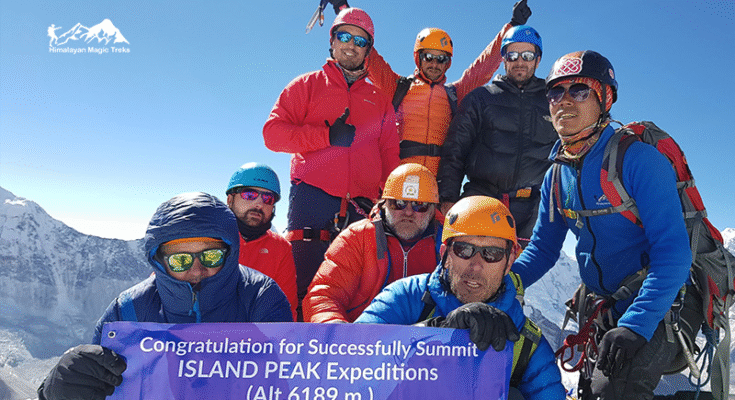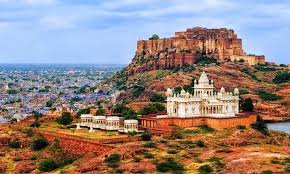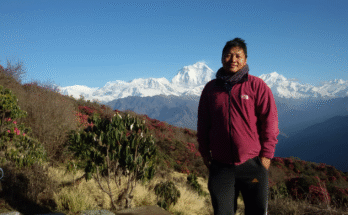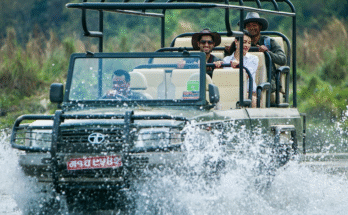Island Peak, officially known as Imja Tse (6,189 m / 20,305 ft), is one of the most popular trekking peaks in Nepal. Located in the Khumbu region of the Himalayas, it rises majestically above the Chhukung Valley, standing as an iconic pyramid-shaped peak surrounded by the world’s highest mountains—Everest, Lhotse, and Makalu.
For adventurers who dream of summiting a Himalayan peak but are not yet ready for the extreme challenges of 8,000-meter expeditions, Island Peak climbing offers the perfect balance of technical mountaineering, cultural immersion, and breathtaking scenery. It is considered an introductory climbing peak, giving mountaineers valuable high-altitude experience without requiring the same commitment or risks as Everest or Ama Dablam.
In this comprehensive guide, we’ll explore everything about Island Peak climbing—from history and route details to preparation, challenges, and why it remains a top choice for climbers around the globe.
The Allure of Island Peak
Island Peak was named by British mountaineers in 1952 because, from Dingboche, the mountain appears like an island rising from a sea of ice. Its location in the Everest region means climbers enjoy the dramatic backdrop of some of the tallest peaks on Earth.
Unlike trekking alone, climbing Island Peak requires technical skills such as rope handling, use of crampons, ice axe techniques, and fixed-line ascents. Yet, it is achievable for dedicated trekkers with good fitness and a strong determination. This accessibility, paired with its stunning setting, makes Island Peak one of Nepal’s most frequently climbed trekking peaks.
Route Overview
Trekking to Base Camp
Most expeditions begin with a flight from Kathmandu to Lukla, followed by a classic trek through Namche Bazaar, Tengboche, Dingboche, and Chhukung. This approach not only provides spectacular Himalayan views but also allows gradual acclimatization.
Island Peak Base Camp (5,087 m) is usually established near Pareshaya Gyab, a flat grassy area beside a small stream. Some teams also set up a High Camp (5,600 m) to shorten summit day, though many expeditions go directly from Base Camp.
Summit Push
The climb typically takes 10–12 hours round trip from Base Camp. The route involves:
- Rock Scramble & Crampon Point – The initial climb is on rocky terrain, leading to the point where climbers put on crampons.
- Glacier Crossing – Teams rope up to cross the Imja Glacier, navigating crevasses and ladders depending on conditions.
- Headwall Ascent – The most challenging section, a steep ice and snow headwall (up to 70 degrees), requires the use of fixed ropes and ascenders.
- Summit Ridge – A short but exposed ridge leads to the summit, rewarding climbers with 360° views of Everest, Lhotse, Nuptse, Ama Dablam, Baruntse, and Makalu.
Difficulty Level
Island Peak is often described as a trekking peak with mountaineering elements. While it does not demand elite climbing expertise, it is far from a simple trek. The main challenges include:
- High Altitude – With a summit over 6,000 m, climbers face thin air, fatigue, and risk of altitude sickness.
- Technical Sections – The glacier traverse and headwall ascent require rope, harness, crampons, and ascender techniques.
- Physical Stamina – Summit day is long and strenuous, demanding endurance and mental resilience.
Climbers with prior trekking experience, strong fitness, and basic mountaineering training can successfully summit with the guidance of experienced climbing Sherpas.
Best Time for Island Peak Climbing
Nepal has two prime climbing seasons for Island Peak:
- Spring (March – May)
- Stable weather, warmer temperatures, and blooming rhododendrons make this the most popular season.
- Clear skies offer excellent summit views.
- Often combined with Everest Base Camp treks.
- Stable weather, warmer temperatures, and blooming rhododendrons make this the most popular season.
- Autumn (September – November)
- Post-monsoon season with clear, dry air and spectacular visibility.
- Cooler than spring but generally very stable.
- Ideal for photography and panoramic vistas.
- Post-monsoon season with clear, dry air and spectacular visibility.
Winter and summer are not recommended due to extreme cold and heavy monsoon rains.
Training & Preparation
Climbing Island Peak requires both physical fitness and technical preparation. Here’s what to focus on:
- Cardio Training – Running, hiking, cycling, and stair climbing build endurance.
- Strength Training – Core and leg workouts prepare for steep ascents with heavy packs.
- Altitude Acclimatization – Prior high-altitude trekking experience (e.g., Everest Base Camp, Annapurna Circuit) is highly recommended.
- Technical Skills – Familiarity with crampons, ice axe, rope systems, and abseiling boosts safety and confidence.
- Mental Readiness – Climbers must be prepared for long summit days, cold nights, and unexpected weather changes.
Many climbers combine the Everest Base Camp Trek with Island Peak climbing, which provides excellent acclimatization before attempting the summit.
Permits & Regulations
Climbing Island Peak requires specific permits:
- Climbing Permit from the Nepal Mountaineering Association (NMA).
- Sagarmatha National Park Entry Permit.
- Khumbu Pasang Lhamu Rural Municipality Entry Permit.
These permits are usually arranged by trekking and expedition companies. Costs vary depending on the season, with spring and autumn being the most expensive.
Equipment Checklist
Essential gear for Island Peak includes:
- Climbing Equipment: Helmet, harness, carabiners, jumar/ascender, belay device, crampons, ice axe, climbing boots.
- Trekking Gear: Warm sleeping bag (-20°C rated), trekking poles, layered clothing, headlamp.
- Safety Gear: Personal first-aid kit, altitude sickness medication, glacier glasses, sunscreen.
Expedition companies often provide group climbing gear (ropes, ladders, tents), while personal gear must be brought or rented in Kathmandu.
Cultural and Natural Highlights
Island Peak climbing is not just about the summit—it’s also a journey through the heart of Sherpa culture and the stunning Khumbu region. Along the trail, trekkers encounter:
- Namche Bazaar – The Sherpa capital with lively markets and mountain views.
- Tengboche Monastery – A spiritual highlight with panoramic views of Everest and Ama Dablam.
- Sherpa Villages – Hospitality, Buddhist traditions, and high-altitude lifestyle enrich the cultural experience.
- Everest Base Camp & Kala Patthar (optional add-ons) – Many itineraries include these iconic landmarks before attempting Island Peak.
The combination of culture, trekking, and climbing makes the journey unforgettable.
Challenges & Risks
While Island Peak is considered achievable, climbers must respect the mountain. Key risks include:
- Altitude Illness (AMS, HAPE, HACE).
- Unpredictable Weather (snowstorms, high winds, sudden temperature drops).
- Technical Hazards (crevasses, avalanches, slipping on steep ice).
- Physical Exhaustion on summit day.
Climbing with experienced guides, following acclimatization schedules, and maintaining proper hydration and nutrition minimize risks.
Why Choose Island Peak?
Island Peak remains one of the best Himalayan peaks for beginners and intermediate climbers. Reasons to attempt it include:
- Relatively affordable compared to major expeditions.
- Provides essential mountaineering skills for future climbs.
- Offers breathtaking Himalayan panoramas.
- Combines trekking, culture, and climbing in one expedition.
- Achievable within 16–20 days from Kathmandu.
It is often a stepping stone for climbers aspiring to tackle higher peaks such as Ama Dablam or Cho Oyu.
Conclusion
Island Peak climbing is more than just a mountaineering challenge—it is a life-changing Himalayan adventure. From trekking through Sherpa villages and acclimatizing in the shadow of Everest, to standing atop a 6,000-meter summit surrounded by the world’s highest mountains, the experience blends physical endurance, technical skills, and cultural discovery.
For those looking to push beyond trekking into true mountaineering, Island Peak offers the perfect introduction. With proper preparation, experienced guides, and respect for the mountain, reaching the summit of Island Peak is an achievable dream that rewards climbers with memories of a lifetime.
Whether you seek a stepping stone toward higher peaks or simply want to experience the thrill of Himalayan climbing, Island Peak remains one of Nepal’s most rewarding and iconic climbs.




